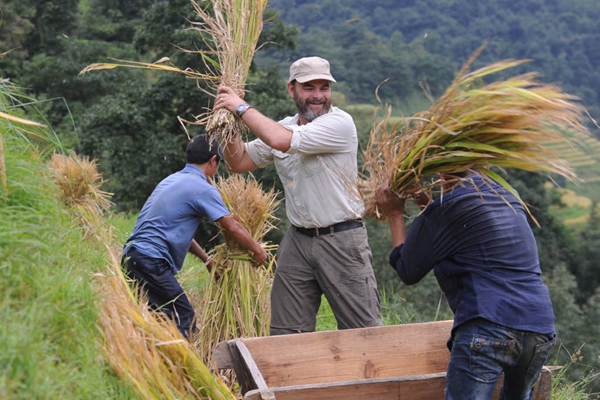French documentary introduces the Miao stockade village
- By Zhang Xin
 0 Comment(s)
0 Comment(s) Print
Print E-mail China Today, July 5, 2016
E-mail China Today, July 5, 2016
 |
|
Colovis Cornillac works in the farmland with his host family. |
Challenging Traditional Impressions
"This was the first time I had been to China. I think more things should be done to challenge French people's stereotype of China," the head writer of Meeting at Unknown Places Franck Desplanques said in an interview. "We added the scene of a modern metropolis, Shanghai, to our program for the first time in order to embody the pluralism of Chinese society." He added that the previous episodes all went straight to the destinations with harsh living conditions, but this time as they shot in China, the scenes of Shanghai were added to present the real and contemporary China to French viewers.
"The Miao stockade village was the most ‘modern' place we went to since we launched our program," Franck Desplanques said. The Miao stockade village was the same as other destinations in that the participants needed to walk for hours to reach the "unknown place," but it was the only one that had access to tap water and electricity. The close-up shot of the electric stove at dinner on the first day tells viewers that this is a village with electricity. Then the one of the water faucet outdoors tells viewers this is a village with water. The anchor, Frédéric Lopez, asked the villagers to recall their feelings 12 years ago when the village first gained access to electricity, demonstrating the process of rural modernization in China. The documentary also briefly introduced the history and residents of the Miao stockade villages, as well as the traditional farming method of the co-existence of fish and rice, hybrid rice farming, and the family planning policy, which are characteristic of China.
The music, full of artistic expression, burnishes this episode. There are folk music, symphonies, and electronic music in Meeting at Unknown Places: Guizhou, which are sometimes independent and sometimes integrated. The music highlights the theme of the program, conveying its humanity in a more appealing way.






Go to Forum >>0 Comment(s)